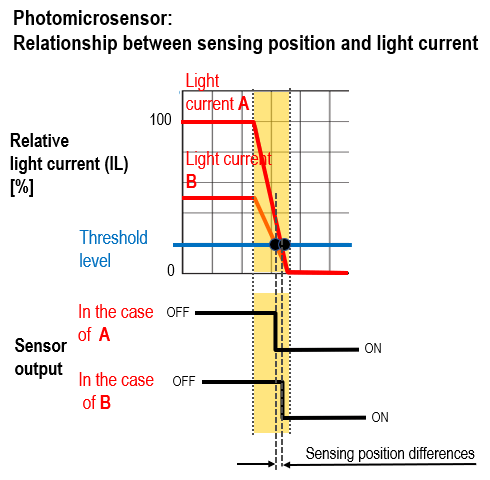What is the accuracy of the sensing position of transmissive Photomicrosensors(photointerrupters)?
ID: FAQE40007E
update:
Answer
With transmissive Photomicrosensors, the width of the aperture attached to the sensor represents the maximum value of the sensing position range.
Explanation
The sensing position range of transmissive Photomicrosensors depends highly on the aperture width. The typical aperture width of the Omron sensor is 0.5 mm and the sensing position accuracy is ±0.25 mm. The following illustration shows the relation between the sensing position and the aperture. The sensor output reverses within the range of the aperture width, but the sensing position changes according to the external circuit setting of the threshold level.

Photomicrosensors are composed of semiconductor components, which the sensing light current varies.
In a typical example: For EE-SX1081 sensor, the standard light current distribution is 0.5-14 mA (refer to the illustration below). The sensing position varies according to the light current condition.
Additionally, the LED characteristics can change over a period of time, and the light emitting power will deteriorate and reduce the light current. As a result, the sensing position will gradually start to deviate from the initial value (refer to the illustration below). When arranging the design of an equipment, users should note that the sensing position of the Photomicrosensors is set within the range of the aperture width due to the condition mentioned above.


Quick tips
- There are two types of Photomicrosensors: phototransistor output type (threshold setting by external circuit) and photo IC output type (fixed threshold setting by internal circuit). The datasheet includes “sensing position characteristics” and “repeated sensing position characteristics” as property data (reference values). As shown in the figure below, from the result of measuring the repeated sensing position 20 times, the dispersion is 0.01 mm. This is also an advantage of optical non-contact switches. However, for a long-term use on equipment, the sensing position will gradually change due to changes in the light current (e.g. LED changes over time, temperature changes, lens contamination). When high-precision position sensing is required for a long period of time, it is recommended to evaluate by changing the light current in actual equipment, considering the relationship between the sensing position and light current.
- Most of Omron’s transmissive type Photomicrosensors are vertical slit types but some are horizontal (e.g. EE-SX1096). Consider this when you want to improve the accuracy of vertical positioning of sensing object.


| Product category | Sensors Photomicro Sensors |
|---|---|
| Classification | Selection, Characteristics |
| Related keywords |
|